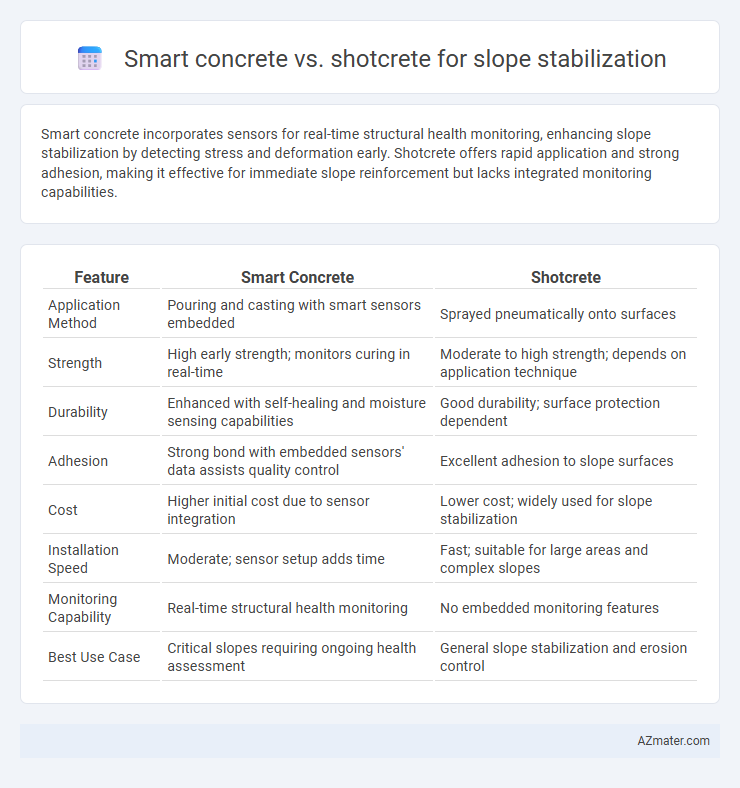Smart concrete incorporates sensors for real-time structural health monitoring, enhancing slope stabilization by detecting stress and deformation early. Shotcrete offers rapid application and strong adhesion, making it effective for immediate slope reinforcement but lacks integrated monitoring capabilities.
Table of Comparison
| Feature | Smart Concrete | Shotcrete |
|---|---|---|
| Application Method | Pouring and casting with smart sensors embedded | Sprayed pneumatically onto surfaces |
| Strength | High early strength; monitors curing in real-time | Moderate to high strength; depends on application technique |
| Durability | Enhanced with self-healing and moisture sensing capabilities | Good durability; surface protection dependent |
| Adhesion | Strong bond with embedded sensors' data assists quality control | Excellent adhesion to slope surfaces |
| Cost | Higher initial cost due to sensor integration | Lower cost; widely used for slope stabilization |
| Installation Speed | Moderate; sensor setup adds time | Fast; suitable for large areas and complex slopes |
| Monitoring Capability | Real-time structural health monitoring | No embedded monitoring features |
| Best Use Case | Critical slopes requiring ongoing health assessment | General slope stabilization and erosion control |
Introduction to Slope Stabilization Techniques
Slope stabilization techniques ensure the structural integrity of slopes by preventing erosion, landslides, and soil movement. Smart concrete integrates fibers, sensors, and self-healing materials to enhance durability and monitor structural health in real time. Shotcrete, a sprayed concrete method, offers rapid application and high adhesion, making it effective for immediate slope reinforcement and surface protection.
What is Smart Concrete?
Smart concrete integrates advanced materials like fibers, sensors, and self-healing agents to enhance durability and monitor structural health in slope stabilization. Unlike traditional shotcrete, which is sprayed concrete applied for immediate reinforcement, smart concrete offers adaptive responses to environmental stress, reducing maintenance needs. This innovation improves slope stability by ensuring real-time damage detection and automatic crack repair, extending the lifespan of reinforced slopes.
Understanding Shotcrete: Basics and Applications
Shotcrete is a pneumatically applied concrete mixture commonly used for slope stabilization due to its rapid application and strong adhesion to irregular surfaces. It consists of cement, aggregates, water, and sometimes additives, applied using a high-velocity hose that ensures dense compaction and reduces rebound waste. Shotcrete is ideal for stabilizing rock faces and slopes, offering immediate structural support and erosion control, making it a widely adopted method in geotechnical engineering.
Material Properties: Smart Concrete vs Shotcrete
Smart concrete incorporates self-healing agents and fiber reinforcement, enhancing durability, crack resistance, and long-term stability in slope stabilization applications. Shotcrete consists of pneumatically applied concrete that provides rapid adhesion and high compressive strength, making it effective for immediate slope support but with less adaptability to ongoing stress. The material properties of smart concrete offer improved sustainability and resilience due to autonomous crack repair, whereas shotcrete excels in quick installation and structural reinforcement under dynamic conditions.
Installation Methods and Equipment
Smart concrete for slope stabilization utilizes advanced sensors and self-healing materials that integrate with robotic installation systems, allowing precise placement and real-time monitoring of structural health. Shotcrete, applied pneumatically through high-velocity nozzles, requires specialized spraying equipment and skilled operators to ensure proper adhesion and compaction on steep slopes. Installation of smart concrete often demands automated machinery and digital controls, contrasting with the more manual, labor-intensive process of shotcrete application.
Durability and Longevity in Slope Stabilization
Smart concrete integrates advanced materials like fibers and self-healing agents that enhance crack resistance and extend durability in slope stabilization projects, reducing maintenance needs. Shotcrete, while effective for rapid application, may exhibit reduced long-term durability due to potential issues like shrinkage and delamination under environmental stress. The superior longevity of smart concrete makes it a preferred choice for slope stabilization requiring sustained structural integrity over decades.
Cost Comparison: Smart Concrete vs Shotcrete
Smart concrete offers a higher upfront cost compared to shotcrete due to its advanced self-healing properties and embedded sensors that reduce long-term maintenance expenses. Shotcrete, while more affordable initially, often incurs additional costs from repairs and recurrent slope stabilization measures over time. Evaluating the total lifecycle costs shows smart concrete providing better value in projects prioritizing durability and reduced intervention frequency.
Environmental Impact and Sustainability
Smart concrete incorporates nanomaterials and self-healing agents that reduce maintenance frequency and increase durability, minimizing environmental disruption over time. Shotcrete, while effective for rapid slope stabilization, often involves higher cement use and energy consumption, contributing to a larger carbon footprint. Employing smart concrete in slope stabilization projects enhances sustainability through reduced resource consumption and extended lifespan, supporting eco-friendly construction practices.
Performance under Extreme Weather Conditions
Smart concrete exhibits superior performance under extreme weather conditions for slope stabilization due to its embedded sensors that enable real-time monitoring of structural health and moisture levels. Shotcrete provides rapid application and strong initial adhesion but lacks adaptive response capabilities, making it less effective in detecting and mitigating damage from freeze-thaw cycles, heavy rainfall, or drought stress. The integration of IoT technology in smart concrete ensures enhanced durability and proactive maintenance, significantly reducing slope failure risks during unpredictable climate events.
Best Practices and Recommendations
Smart concrete integrates sensors and real-time monitoring technology to provide enhanced durability and stress detection, making it ideal for slope stabilization in regions prone to landslides or seismic activity. Shotcrete, known for its rapid application and strong adhesion, offers effective immediate ground support, especially in steep or irregular slopes. Best practices recommend using smart concrete for long-term monitoring and maintenance planning, while shotcrete serves as a reliable solution for quick stabilization and erosion control on challenging terrain.

Infographic: Smart concrete vs Shotcrete for Slope stabilization
 azmater.com
azmater.com